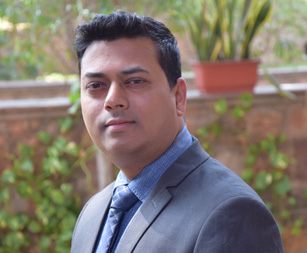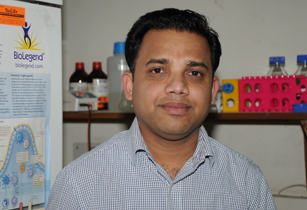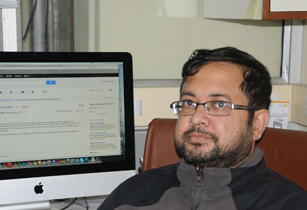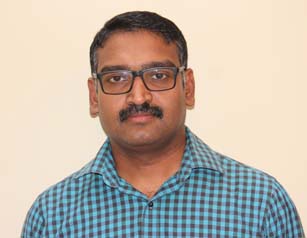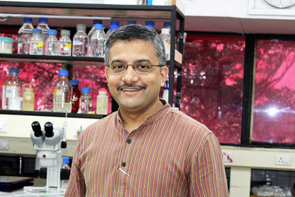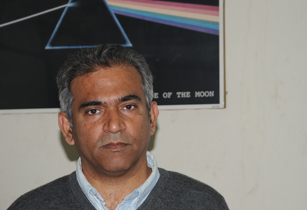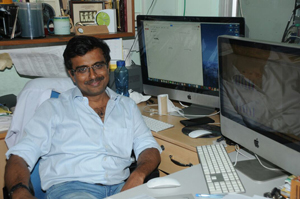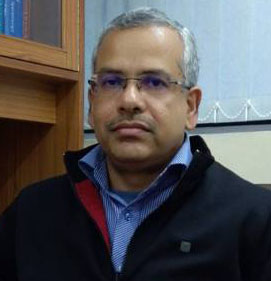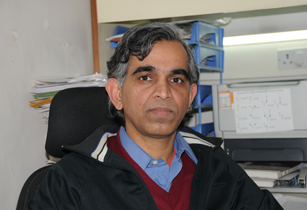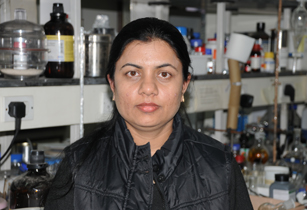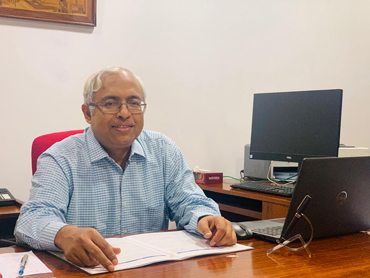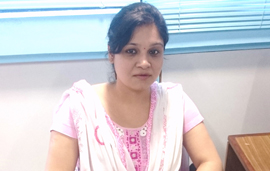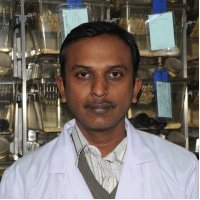Dr. Anil Kumar
Microbiome and Human Cancer
There are increasing research reports which establish the link between human microbiota and carcinogenesis. Pathogenic bacteria and altered microbiota interact with mucosal surface and as a result, epithelial damage can be seen especially in chronic infection conditions. It can be reckoned that gut microbiota-derived metabolites play key role in epithelial damage and carcinogenesis. Recent intriguing data is hinting at a much broader link between microbiota, bacterial infections, inflammation and carcinogenesis. The mechanism of this relationship between bacteria and human cancer is not well studied and understood, hence our laboratory aim to delineate this complex interaction among microbiota, bacterial infections, inflammation and carcinogenesis. We are also exploring the role of bacteria, microbiota and their metabolites in enhancing cancer immunotherapy.
Current Projects
1. Towards understanding the link between intestinal microbiota and colorectal cancer
The gut microbiota is considered as a forgotten organ in human health and disease. It maintains gut homeostasis by various complex mechanisms.The dysbiosis or disruption of gut flora has been confirmed to be related to gastrointestinal diseases such as CRC and other diseases in different organs. Colorectal cancer is a multi-factorial and multi-stage involved disorder. The role of microorganisms that initiate and facilitate the process of colorectal cancer has become clear. Our group is studying the link of gut microbes in colorectal cancer causation. Clearly, more information is needed about the mechanisms through which the microbial community promotes carcinogenesis. Understanding the events leading to the development of intestinal carcinogenesis through gut microbes will provide novel insight into this pathology, and potentially lead to new therapeutic modalities targeting the microbiota.
2. Role of oral microbiota in colorectal cancer progression and Carcinogenesis
Recent reports indicate that the oral microbiome can colonize the gut, leading to dysregulation of the gut microbes. Furthermore, the oral-gut microbes create an intestinal inflammatory and immunosuppressive microenvironment conducive to tumorigenesis and progression of colorectal cancer. Our group is identifying oral bacteria and their metabolites which may be implicated for their genotoxic and carcinogenic role leading to colorectal cancer progression and carcinogenesis. This project is also aimed at studying oral to intestinal microbial transmission and the inflammatory and immunosuppressive microenvironment, induced by oral-gut axis microbes in the gut.
3. Sensor/biosensor for detection of gut bacteria and their metabolites
The microbiota-derived metabolites such as TMAO, TMA, Indoxyl sulfate, PCS, EPS, colibactin etc have been implicated in human health and disease, and their early detection in the body fluids is thought to be significant in understanding the pathogenesis and treatment of colorectal cancer and other diseases like Alzheimer’s disease, cardiovascular, cerebrovascular etc. These metabolites can also be considered as biomarkers for diagnosis of different diseases; hence our laboratory is involved in developing sensors/biosensors for quantifying the gut metabolites in body fluids like blood and urine.
Manish Kushwaha, Jayesh Kumar Sevak, Pallavi Khodlan, Anupam Teotia, Payal Rana, Lavaniya Nagrath, Simran and Sushmita Saurav
Awards:
• CSIR Technology Award, 2012.
• Merck Millipore India Innovation Award, 2012.
• 'Young Scientist Award’ from IUBMB, 2006.
• ‘Young Investigator Award’ from HUPO, 2004.
• Merit Scholarship from DBT during M.Sc. at IIT Roorkee.
Funding:
Current funding of our laboratory is from the Department of Biotechnology (DBT), ICMR, DHR and DRDO. We also acknowledge funding from NII.
Patents:
Granted
• US6896806 • US7018510 • US7022511 • US 7179633 • US7267772
• US7429478 • US7736879 • US7906008 • US8080403 • US7396671
• EP1613739 • EP1611282 • EP1836133 • EP1831682 • EP1996520
• GB1613739 • GB1831682 • GB1836133 • GB1996520 • IN221931
• IN224060 • IN231224 • IN243806 • IN244344 • IN244801
• FI120771 • A2008/07816 • ZA 2005/7593 • CN352084 • SE529680
• CN 368495 • FI1613739 • SE1613739 • DE1613739 • CN200380110308.1
• FR1996520 • ZA 2007/5292 • ZA2007/05230 • ZA2007/05225 • ZA2005/07609
• FI1611282 • AU2004326112 • FR1611282 • SE1611282 • CNZL200480044738.2
• DK1836133 • AU2004326074 • AU2004326080 • DE1611282 • AU2004326113
• DK1831682 • AU2007226332 • BE1996520 • DE1996520 • CNZL200480044739.7
• CH1996520 • IT1996520 • ES1996520 • ZA2005/7592
Filed
• 202111006093 • 202011037663 • 202011030135
• 201911044566 • 201911042412 • 201911010966
- Verma H, Gulati P, Malik T, Verma AK, Teotia A, Archana, Lakshmi GBVS, Tariq M, Jaiswal J, Kushwaha M, Solanki PR, Singh R and Kumar A* (2025) Investigation of intermolecular interaction between 4-Ethyl Phenyl Sulfate and human serum albumin using spectroscopic techniques and molecular docking studies. J Mol Recognit. https://doi.org/10.1002/jmr.70015 *denotes corresponding author
- Z Hashmi, Archana, Kumar A and Solanki PR (2025) SnO2-rGO embedded molecularly imprinted polypyrrole based disposable sensing platform utilizing MWCNT for enhanced detection of para-cresyl sulphate Electrochim Acta., 147654. https://doi.org/10.1016/j.electacta.2025.147654
- Dalal N, Jaiswal J, Kushwaha M, Verma H, Rana P, Gupta S, Panwar R, Janmeda P, Jain P, Singh AK, Mohan A, Kumar A* (2025) Implications of Gut Microbiota-Derived Metabolites in Neurological Disorders. ACS Chem Neurosci. DOI 10.1021/acschemneuro.5c00414. *denotes corresponding author
- Teotia A, Bashir S, Malik T, Mohan A, Tariq M, Kumar A* and Singh R (2025) Sustainable management of bovine mastitis caused by major pathogens (Staphylococcus aureus, Escherichia coli, Streptococcus agalactiae, and Streptococcus uberis) using medicinal plants: a review. Dairy Sci. Manag. 2. https://doi.org/10.1186/s44363-025-00010-0 *denotes corresponding author
- Kathpalia KV, Verma AK, Mohan A, Girdhar M, Shankhwar N, Malik T, Sharma NR and Kumar A*(2025) Optimized fungal chitosan‑based pegasparaginase immobilization for intravenous delivery to enhance treatment of acute lymphoblastic leukaemia. Futur J Pharm Sci . https://doi.org/10.1186/s43094-025-00875-7 *denotes corresponding author
- Bashir S, Kaur N, Vadhel A, Verma,AK, Girdhar M, Malik T, Kumar A and Mohan, A (2025) Unravelling herbicide stress and its impact on metabolite profiling in Cannabis sativa: an investigative study. J Cannabis Res, 7. DOI:10.1186/s42238-025-00300-z
- Saurav S, Sharma P Mohan A, Kumar A, Heer A, Siddiqui MA, Al-Khedhairy AA, Malik T, and Girdhar M (2025) Synergistic reinforcement of regenerated silk fibroin with LAPONITE and organomodified montmorillonite for bone tissue engineering. New J. Chem. DOI https://doi.org/10.1039/D5NJ02429C
- Tabassum Z, Anand A, Bhanot R, Girdhar M, Kumar A, Mamidi N and Mohan A (2025) Xanthan Gum-Driven Innovations for Reinventing Food Preservation. Polymers (Basel). (Accepted)
- Yadav M, Gupta A, ……. Dalal N ……. Kushwaha M …… Kumar A, Kumar N, Tripathi DM, Trehanpati N, kumara A, Sharma S, Sarin SK and Maras JS (2025) Circulating urobilinogen contributes to Inflammation, Intestinal Permeability and corticosteroid non-response in Severe Alcohol-associated Hepatitis. Molecular Therapy.
- Jaiswal J, Srivastav AK, Kushwaha M, Teotia A, Singh R, Mohan A, Makharia G, Kumar A* (2025) Gut Microbial Metabolite 4-Ethylphenylsulfate Is Selectively Deleterious and Anticancer to Colon Cancer Cells. J Med Chem. 2025 doi: 10.1021/acs.jmedchem.5c00609. *denotes corresponding author
- Kushwaha M, Dalal N, Chaudhary S, Ahmed A, Makharia GK , Singh AK and Kumar A* (2025) Colon cancer biofilm composition reveals distinct bacterial species signature. Appl Microbiol Biotechnol. (Accepted). *denotes corresponding author
- Kushwaha M, Chaudhary S, Singh AK, Makharia GK and Kumar A* (2025) Bacterial profiling of colorectal cancer biopsies: a culture-based study in Indian patients. Front. Cell. Infect. Microbiol. Volume 15 - 2025 | doi: 10.3389/fcimb.2025.1535477. *denotes corresponding author
- Verma AK, Gulati P, Lakshmi GBVS, Mohan A, Sharma NR, Solanki PR and Kumar A* (2025) Interaction studies unveil potential binding sites on bovine serum albumin for gut metabolite trimethylamine n-oxide (TMAO). BMC Chemistry 19, 22 (2025). https://doi.org/10.1186/s13065-024-01375-0 *denotes corresponding author
- Verma AK, Lakshmi GBVS, Dhiman TK, Hashmi SZH, Kumar A* and Solanki PR (2025) Optical tuning of polymer functionalized zinc oxide quantum dots as a selective probe for the detection of antibiotics. Sci Rep. DOI: 10.1038/s41598-024-62827-0 *denotes corresponding author
- Gulati P, Tripathi P, Sharma C and Kumar A (2025) Screening of broad range aptamer and its implication in electrochemical aptasensor for para-cresol sulfate detection, a possible biomarker for chronic kidney disease. Microchemical Journal. https://doi.org/10.1016/j.microc.2025.114070
- Archana, Kumar A and Solanki PR (2025) Chitosan-supported molecularly imprinted polypyrrole@MoSe2 nanosheets based bioinspired electrochemical sensor for improved quantification of gut microbiota derived hippuric acid. ACS Appl. Bio Mater. doi: 10.1021/acsabm.5c00329.
- Kumar P, Kumar A and Kumar V (2025) Role of microbiota-derived metabolites in prostate cancer inflammation and progression. Cell Biochem Funct. DOI: 10.1002/cbf.70050
- Kaur N, Kumar A, Malik T, Girdhar M, Singh M, Singh R, Tariq M and Mohan A (2025) Herbicide use and weed management strategies in hemp cultivation. J Cannabis Res. https://doi.org/10.1186/s42238-025-00280-0
- Bashir S, Maqsood S, Khedhairy A, Abdulaziz, Girdhar M, Malik T, Kumar A and Mohan A (2025) Herbicide-Induced Alterations in Hemp Fiber: A Comparative Analysis of Strength and Morphology. Journal of Engineered Fibers and Fabrics. DOI 10.1177/15589250251319321
- Kumar R, Kumari P, Gaurav N, Kumar R, Singh D, Malhotra P, Singh SK, Bhatta RS, Kumar A, Nagarajan P, Singh S, Dalal N, Roy BG, Bhatt AN, Chandna S. N-acetyl-L-tryptophan provides radioprotection to mouse and primate models by antagonizing the TRPV1 receptor and substance P inhibition. Int J Radiat Biol. 2024 Dec 16:1-26. doi: 10.1080/09553002.2024.2435330
- Bhatnagar K, Jha K, Dalal N, Patki N, Gupta G, Kumar A, Kumar A and Chaudhary S (2024) Exploring micronutrients and microbiome synergy: pioneering new paths in cancer therapy. Front. Immunol. 15:1442788. doi: 10.3389/fimmu.2024.1442788
- Kaur, R.; Gupta, S.; Kulshrestha, S.; Khandelwal, V.; Pandey, S.; Kumar, A.; Sharma, G.; Kumar, U.; Parashar, D.; Das, K. Metabolomics-Driven Biomarker Discovery for Breast Cancer Prognosis and Diagnosis. Cells (mdpi) 2025, 14, 5. https://doi.org/10.3390/ cells14010005
- Tabassum Z, Girdhar M, Anand A, Kumar N, Sood B, Tabarak M, Kumar A, and Mohan A (2024) Trash to Treasure: Advancing Resource Efficiency with Waste-Derived Fillers as Sustainable Reinforcing Agents in Bioplastics. Mater. Adv. (Accepted)
- Gulati P, Solanki P, Verma AK, Kumar A (2024) Interaction of 4-ethyl phenyl sulfate with bovine serum albumin: Experimental and molecular docking studies. PLoS ONE 19(10): e0309057. https://doi.org/10.1371/journal.pone.0309057
- Chakravorty S, Archana, Lakshmi G, Solanki PR, Kumar A*. Trimethylamine N-oxide detection by electrochemical sensor based on screen printed electrode modified with molecularly imprinted polypyrrole-molybdenum(III) sulfide nanosheets. Colloids Surf B Biointerfaces. 2024 Dec;244:114164. doi: 10.1016/j.colsurfb.2024.114164 *denotes corresponding author
- Kaur N, Verma AK, Girdhar M ,Kumar A, Siddiqui MA , Al-Khedhairy AA, Malik T and Mohan A. (2024) Genome-wide analysis of the Cannabis sativa cytochrome P450 monooxygenase superfamily and uncovering candidate genes for improved herbicide tolerance. Front. Plant Sci. Volume 15 - 2024 doi: 10.3389/fpls.2024.1490036
- Archana, Gupta AK, Noumani A, Panday DK, Zaidi F, Sahu GK, Joshi G, Yadav M, Borah SJ, Susmitha V, Mohan A, Kumar A*, Solanki PR. Gut microbiota derived short-chain fatty acids in physiology and pathology: An update. Cell BiochemFunct. 2024 Sep;42(7):e4108. doi: 10.1002/cbf.4108. *denotes corresponding author
- Tabassum Z, Madhuri Girdhar, Tabarak M, Kumar A, and Mohan A (2024) Advancing sustainability: a novel biopolymer-based degradable nanoclay composite film for next-generation packaging. Mater. Adv. https://doi.org/10.1039/D4MA00476K
- Sharma P, Saurav S, Tabassum Z, Sood BK, Kumar A, Malik T, Mohan A, Girdhar M (2024) Polymers, Nanomaterial, Their Application and Intervention in Alveolar Bone Regeneration and Tooth Dentistry. RSC Adv.
- Archana, Kumar A* and Solanki PR (2024) 4-ethylphenyl sulfate detection by electrochemical sensor based on MoS2 nanosheets modified molecularly imprinted biopolymer. ACS Appl. Bio Mater. https://doi.org/10.1021/acsabm.4c00227 *denotes corresponding author
- Archana, Hashmi SZH, Bhardwaj H, Kumar A* and Solanki PR* (2024) Reduced graphene oxide nanosheets enhance the sensitivity of p-cresyl sulfate detection using a molecularly imprinted polymer based electrochemical sensor. ACS Appl. Polym. Mater https://doi.org/10.1021/acsapm.4c00435 *denotes corresponding author
- Jalandra R, Dalal N, Mohan A, Solanki PR, Kumar A* (2024) A novel method for enrichment of Morganella morganii in fecal samples using designed culture medium. Cell BiochemFunct. DIO: 10.1002/cbf.4004 3c01907 *denotes corresponding author
- Kushwaha M, Singh AK, Vanditha N, Makharia GK, Mohan A, Kumar A* and Dalal N* (2024) Emerging implications of bacterial biofilm in cancer biology: Recent updates and major perspectives. Gut Microbes Reports. http://dx.doi.org/10.1080/29933935.2024.2339270 *denotes corresponding author
- Mehra P and Kumar A* (2024) Emerging importance of stool preservation methods in OMICS studies with special focus on cancer biology. Cell Biochem Funct. DOI: 10.1002/cbf.4063 *denotes corresponding author
- Kumar S, Mohan A, Sharma NR, Kumar A, Girdhar M, Tabarak M and Verma AK (2024) Computational Frontiers in Aptamer-Based Nanomedicine for Precision Therapeutics: A Comprehensive Review. ACS Omega https://doi.org/10.1021/acsomega.4c02466
- Yadav M, Vaishkiar I, Sharma A, Shukla A, Mohan A, Girdhar M, Kumar A, Malik T and Mohan A (2024) Estrogen Receptor Positive Breast cancer and its embedded mechanism: Breast cancer resistance to conventional drugs and related therapies, a review. Open Biol. 2024 Jun;14(6):230272. doi: 10.1098/rsob.230272
- Saurav S, Sharma P, Kumar A, Tabassum Z, Girdhar M, Mamidi N, Mohan A (2024) Harnessing Natural Polymers for Nano-Scaffolds in Bone Tissue Engineering: A Comprehensive Overview of Bone Disease Treatment. Curr. Issues Mol. Biol. 46, 585-611. https://doi.org/10.3390/cimb46010038
- Dalal N, Makharia GK, Dalal M, Mohan A, Singh R, Kumar A* (2023) Gut metabolite indoxyl sulfate has selective deleterious and anticancer effect on colon cancer cells. J. Med. Chem. https://doi.org/10.1021/acs.jmedchem.3c01907 *denotes corresponding author
- Jalandra R, Sharma M, Makharia GK, Kumar A* (2023) Inflammatory and deleterious role of gut microbiota-derived trimethylamine on colon cells. Front Immunol. 2022; 13: 1101429. doi: 10.3389/fimmu.2022.1101429. *denotes corresponding author
- Upadhyay P, Tyagi A, Agrawal S, Kumar A, Gupta S (2023) Bidirectional effect of Triphala on modulating Gut-brain axis to improve cognition in the Murine Model of Alzheimer’s disease. Mol Nutr Food Res. DOI: 10.1002/mnfr.202300104
- Vadhel A, Kumar A, Bashir S, Malik T and Mohan A (2023) Synergistic and non-synergistic impact of HAP-based Nano fertilizer and PGPR for improved nutrient utilization and metabolite variation in Hemp crop. Environ. Sci.: Nano. DOI: 10.1039/d3en00380a
- Tabassum Z, Madhuri Girdhar, Kumar A, Tabarak M and Mohan A (2023) ZnO nanoparticles reinforced chitosan-xanthan gum blend novel film with enhanced properties and degradability for application in food packaging. ACS Omega. 8, 34, 31318–31332. https://doi.org/10.1021/acsomega.3c03763
- Archana, Verma D, Hashmi SZH, Lakshmi GBVS, Sajwan RK, Kumar A* and Solanki PR (2023) Electrochemical sensor based on polydopamine-molecularly imprinted polymer for detection of 4-ethylphenyl sulfate “a novel gut metabolite”: Fabrication, characterization, and performance evaluation in human urine. Microchemical Journal, 193, 108964. DOI: 10.1016/j.microc.2023.108964. *denotes corresponding author
- Jalandra R, Lakshmi GBVS, Dhiman TK, Sharma M, Kumar A* and Solanki PR (2023) MIP based sensor for detection of gut microbiota derived Trimethylamine. J. Electrochem. Soc. 170 027504. DOI 10.1149/1945-7111/acb7a3. *denotes corresponding author
- Gulati P, Verma AK, Kumar A and Solanki P (2023) Para-cresyl sulfate and BSA conjugation for developing aptasensor: Spectroscopic methods and molecular simulation. ECS J. Solid State Sci. Technol. DOI 10.1149/2162-8777/ace286
- Vadhel A, Bashir S, Mir AH, Girdhar M, Kumar D, Kumar A, Mohan A, Malik T, Mohan A (2023) Opium alkaloids, biosynthesis, pharmacology and association with cancer occurrence. Open Biol. 13(5):220355. doi: 10.1098/rsob.220355.
- Shukla A, Kumar D, Girdhar M, Kumar A, Goyal A, Mohan A and Malik T (2023) Strategies of Pretreatment of Feedstocks for Optimized Bioethanol Production: Distinct and Integrated Approaches. Biotechnol Biofuels 16, 44 (2023). https://doi.org/10.1186/s13068-023-02295-2
- Tabassum Z, Mohan A, Khosla A, Solanki PR, Kumar A, Narsimha Mamidi and Madhuri Girdhar (2023) Recent trends in nanocomposite packaging films utilising waste generated biopolymers: Industrial symbiosis and its implication in sustainability. IET Nanobiotechnol. 1–27. https://doi.org/10.1049/nbt2.12122
- Dalal N, Dhiman TK, Lakshmi GBVS, Singh AK, Solanki PR and Kumar A* (2022) MIP based sensor for detection of gut microbiota-derived Indoxyl Sulfate using PANI-Graphene-NiS2. Mater. Today Chem. 26, 2022,10115. ,https://doi.org/10.1016/j.mtchem.2022.10115. *denotes corresponding author
- Verma D, Sajwan RK, Lakshmi GBVS, Kumar A* and Solanki P (2022) A Molecularly Imprinted Polymer based on Novel Polyaniline–Zinc Sulfide Nanocomposite for Electrochemical Detection of Trimethylamine N-Oxide. Environ. Sci.Nano, 2022,9, 3992-4006. https://doi.org/10.1039/D2EN00624C. *denotes corresponding author
- Yadav AK, Verma D, Dalal N, Kumar A, Solanki PR (2022) Molecularly Imprinted Polymer-based Nanodiagnostics for Clinically pertinent Bacteria and Virus Detection for Future Pandemics. Biosensors and Bioelectronics: X, 12, 2022, 100257. https://doi.org/10.1016/j.biosx.2022.100257
- Sharma R, Lakshmi GBVS, Kumar A* and Solanki P (2022) Plypyrrole Based Molecularly Imprinted Polymer Platform for Klebsiella pneumonia Detection. ECS Sens. Plus 1 010603, http://dx.doi.org/10.1149/2754-2726/ac612c. *denotes corresponding author
- Verma D, Yadav AK, Chaudhary N, Mukherjee MD, Kumar P, Kumar A*, Solanki PR (2022) Recent advances in understanding SARS-CoV-2 infection and updates on potential diagnostic and therapeutics for COVID-19. Coronaviruses. 3, 4, 2022, pp. 14-31(18). https://doi.org/10.2174/2666796703666220302143102. *denotes corresponding author
- Lakshmi GBVS, Yadav AK, Mehlawat N, Jalandra R, Solanki PR and Kumar A* (2021) Gut microbiota derived trimethylamine N-oxide (TMAO) detection through molecularly imprinted polymer based sensor. Sci Rep. 11, 1338 (2021). https://doi.org/10.1038/s41598-020-80122-6. *denotes corresponding author
- Mohan A, Girdhar M, Kumar R, Chaturvedi HS, Vadhel A, Solanki P, Kumar A, Kumar D, Mamidi N (2021) Polyhydroxy butyrate-based nanocomposites for bone tissue engineering. Pharmaceuticals. 14, 1163. https://doi.org/10.3390/ph14111163
- Jalandra R, Dalal N, Yadav AK, Verma D, Sharma M, Singh R, Khosla A, Kumar A, Solanki PR (2021) Emerging role of trimethylamine-N-oxide (TMAO) in colorectal cancer. Appl Microbiol Biotechnol.Oct;105(20):7651-7660. doi:10.1007/s00253-021-11582-7.
- Dhiman TK, Lakshmi GBVS, Dave K, Roychoudhury A, Dalal N, Jha SK, Kumar A, Han KH and Solanki PR (2021) Rapid and label-free electrochemical detection of fumonisin-b1 using microfluidic biosensing platform based on Ag-CeO2 nanocomposite. J. Electrochem. Soc. DOI:10.1149/1945-7111/ac13cf
- Dalal N, Jalandra R, Bayal N, Yadav AK, Harshulika, Sharma M, Makharia GK, Kumar P, Singh R, Solanki P, Kumar A* (2021) Gut microbiota-derived metabolites in CRC progression and causation. J. Cancer Res. Clin. Oncol. DOI:10.1007/s00432-021-03729-w. *denotes corresponding author
- Yadav AK, Verma D, Chaudhary N, Kumar A and Solanki PR (2021) Aptamer based switches: A futuristic approach for Helicobacter pylori detection. Materials Letters 2022, 308 , 131239. https://doi.org/10.1016/j.matlet.2021.131239
- Hashmi Z, Dhiman TK, Chaudhary N, Singh AK, Kumar A* and Solanki PR (2021) L-Cysteine capped MgS quantum dots and their application in optical detection of levofloxacin. Front. Nanotechnol.3,2. DOI: 10.3389/fnano.2021.616186. *denotes corresponding author
- Yadav AK, Verma D, Kumar P, Kumar A and Solanki PR (2021) The perspectives of biomarkers based electrochemical immunosensors, artificial intelligence and the internet of medical things towards COVID-19 diagnosis and management. Mater. Today Chem. Vol 20, 100443. https://doi.org/10.1016/j.mtchem.2021.100443
- Dalal N, Jalandra R, Sharma M, Prakash H, Makharia GK, Solanki P, Singh R, Kumar A* (2020) OMICS technologies for improved diagnosis and treatment of colorectal cancer: Technical advancement and major perspectives. Biomed Pharmacother. 131, 2020, 110648. https://doi.org/10.1016/j.biopha.2020.110648. *denotes corresponding author
- Jalandra R, Yadav AK, Verma D, Dalal N, Sharma M, Singh R, Kumar A*, Solanki P (2020) Strategies and perspectives to develop SARS-COV-2 detection methods and diagnostics. Biomed Pharmacother. 129, 2020, 110446. https://doi.org/10.1016/j.biopha.2020.110446 *denotes corresponding author
- Toor D, Wsson MK, Kumar P, Karthikeyan G, Kaushik NK, Goel C, Singh S, Kumar A and Prakash H (2019) Dysbiosis Disrupts Gut Immune Homeostasis and Promotes Gastric Diseases. Int J Mol Sci. 2019 May 16;20(10):2432. doi: 10.3390/ijms20102432.
- Reena, Dhall P, Kumar R and Kumar A* (2014) Validation of computationally predicted substrates for laccase. Braz. arch. biol. Technol 57(5):803-809 DOI:10.1590/S1516-8913201402239*denotes corresponding author
- Kumar V, Dhall P, Naithani S, Kumar A*, Kumar R (2014) Biological Approach for the Treatment of Pulp and Paper Industry Effluent in Sequence Batch Reactor. J BioremedBiodeg5:218. doi: 10.4172/2155-6199.1000218. *denotes corresponding author
- Kulshreshtha NM, Kumar R, Begum Z, Shivaji S, Kumar A* (2013) Exiguobacteriumalkaliphilum sp. nov. isolated from alkaline wastewater drained sludge of a beverage industry located in India Int J SystEvolMicrobiol, ijs.0.039123-0; doi:10.1099/ijs.0.039123-0. *denotes corresponding author
- Majhi MC, Behera AK, Kulshrestha NM, Mahmooduzafar, Kumar R, Kumar A* (2012) Extreme: A unified web repository of extremophilic microorganisms PLoS ONE, 8(5): e63083. doi:10.1371/journal.pone.006308. *denotes corresponding author
- Dhall P, Siddiqi TO, Ahmad A, Kumar R, Kumar A* (2012) Rapid monitoring and assessment of pollutional load in Dairy Waste Water. Anal. Methods, 2013,5, 977-981. DOI: 10.1039/C2AY26269J. *denotes corresponding author
- Dhall P, Kumar R, Siddiqi TO and Kumar A* (2012) Selection of an apt support for immobilization of microbes for developing BOD biosensor. Anal. Methods, 2013, DOI: 10.1039/C2AY26208H. *denotes corresponding author
- Dhall P, Kumar R, Kumar A* (2012) BODBEADS – A ready to use seeding material for estimation of organic load of wastewater Anal. Methods, 2012,4, 4101-4106DOI: 10.1039/C2AY25960E. *denotes corresponding author
- Saxena M, Gupta S, Kumar R, Mahmooduzzafar, Kumar A* (2012) Identification and genetic characterization of phenol-degrading bacterium isolated from oil contaminated soil Afr J Biotechnol12(8): 791 – 797. *denotes corresponding author
- Kumar A* Dhall P, Kumar R, (2012) Biological AOX removal of pulp mill plant effluent by Pseudomonas J Environ EngLandscManagID: 745413 DOI:10.3846/16486897.2012.745413. *denotes corresponding author
- Gupta S, Saxena M, Saini N, Mahmooduzzafar, Kumar R, Kumar A* (2012) An Effective Strategy for a Whole-Cell Biosensor Based on Putative Effector Interaction Site of the Regulatory DmpR Protein. PLoS One. 2012;7(8):e43527. doi: 10.1371/journal.pone.0043527.*denotes corresponding author
- Kulshreshtha NM, Kumar A, Bisht G, Pasha S and Kumar R (2012) Usefulness of Organic Acid Produced by Exiguobacterium sp. 12/1 on Neutralization of Alkaline Wastewater. ScientificWorldJournal.(Wiley)2012:345101. https://doi.org/10.1100/2012/345101
- Dhall P, Siddiqi TO, Ahmad A, Kumar R, and Kumar A* (2012) Re-structuring BOD:COD ratio of dairy mill industrial wastewaters in BOD analysis by formulating a specific microbial see. ScientificWorldJournal. (Wiley) 012;2012:105712. doi: 10.1100/2012/10571. *denotes corresponding author
- Reena, Majhi MC, Arya AK, Kumar R and KumarA (2012) BioRadBase: A database for bioremediation of radioactive waste. Afr J Biotechnol11 (35): 8718-8721. DOI:10.5897/AJB12.020.
- Dhall P, Kumar R and Kumar A* (2012) Biodegradation of sewage waste water using autochthonous bacteria. ScientificWorldJournal. (Wiley) 2012:86190. https://doi.org/10.1100/2012/861903 *denotes corresponding author
- Kumar V, Dhall P, Kumar R, Prakash Singh Y, Kumar A. (2012) Bioremediation of agro-based pulp mill effluent by microbial consortium comprising autochthonous bacteria. ScientificWorldJournal. (Wiley) 2012;2012:127014. doi: 10.1100/2012/127014
- Gahoi S, Mandal RS, Ivanisenko N, Shrivastava P, Jain S, Singh AK, Raghunandanan MV, Kanchan S, Taneja B, Mandal C, Ivanisenko VA, Kumar A, Kumar R; Open Source Drug Discovery Consortium; Ramachandran S. Computational screening for new inhibitors of M. tuberculosis mycolyltransferases antigen 85 group of proteins as potential drug targets. J Biomol Struct Dyn. 2013;31(1):30-43. doi: 10.1080/07391102.2012.691343.
- Saini R, Kapoor R, Kumar R, Siddiqui TO and Kumar A (2011) CO2 utilizing microbes-A comprehensive review. Biotechnol Adv. 2011 Nov-Dec;29(6):949-60. doi: 10.1016/j.biotechadv.2011.08.009.
- Suresh PS, Kumar R and Kumar A (2011) Three dimensional model for N-terminal A domain of DmpR (2-dimethylphenol) protein based on secondary structure prediction and fold recognition. In Silico Biol. 2010;10(5-6):223-33. doi: 10.3233/ISB-2010-0434.
- Singh Y, DhallP, Mathur R, Jain R, Thakur V, Kumar V, Kumar R and Kumar A (2011) Bioremediation of pulp and paper mill effluent by tannic acid degrading Enterobacter sp. Water Air Soil Pollut 218, 693–701 (2011). https://doi.org/10.1007/s11270-010-0678-4
- Saini R, Majhi MC, Kapoor R, Kumar R and Kumar A (2011) Carbon dioxide (CO2) utilizing strain database. Afr J Biotechnol10(63):13818-13822. https://doi.org/10.5897/AJB10.2643
- Rani A, Jain S, Dureja P, Kumar R and Kumar A (2011) Synthesis of some 3-(5-chloro-1,3-diaryl-1H-pyrazol-4-yl)-1-arylprop-2-en-1-ones and 1,5-bis(5-chloro-1,3-diaryl-1H-pyrazol-4-yl)pent-1,4-diene-3-ones and their antimicrobial activity. Indian J Chem B Org 50B:1534-1531
- Joshi S, Bisht GS, Rawat DS, Kumar A, Kumar R, Maiti S and Pasha S (2010) Interaction studies of novel cell selective antimicrobial peptides with model membranes and E. coli ATCC 11775. Biochim Biophys Acta. 2010 Oct;1798(10):1864-75. doi: 10.1016/j.bbamem.2010.06.016.
- Kumar A, Dhall P and Kumar R (2010) Redefining BOD:COD ratio of pulp mill industrial wastewaters in BOD analysis by formulating a specific microbial seed. Int Biodeterior Biodegradation 64(3):197-202 https://doi.org/10.1016/j.ibiod.2010.01.005
- Rani A, Jain S, Kumar R and Kumar A (2010) 1,5-Bis (2-Hydroxyphenyl) Pent-1,4-Diene-3-One: A Lead Compound for the Development of Broad-spectrum Antibacterial Agents. S Afr J Chem 63:31-35
- Kulshreshtha NM, Kumar A, Dhall P, Bisht G, Pasha S, Gupta S and Kumar R (2010) Neutralization of alkaline industrial wastewaters using Exiguobacterium sp. Int BiodeteriorBiodegradation 64(3):191-196. https://doi.org/10.1016/j.ibiod.2010.01.003
- Tiku DK, Kumar A, Chaturvedi R, Makhijani SD, Manoharan A and Kumar R (2010) Holistic bioremediation of pulp mill effluents using autochthonous bacteria. Int Biodeterior Biodegradation 64(3): 173-183 https://doi.org/10.1016/j.ibiod.2010.01.001
- Saini R, Majhi MC, Kapoor R, Kumar A and Kumar R (2009) CSD: A database of CO2 utilizing strains. Environ Model Software 24(9):1133-1134. https://doi.org/10.1016/j.envsoft.2009.02.016
- Rani A, Jain S, Dureja P, Kumar R and Kumar A (2009) Synergistic interaction between synthetic and natural products: a promising tool for the development of environmentally safe potent antimicrobial agents. World Appl Sci J 5:59-63
- Suresh PS, Kumar A, Kumar R and Singh VP (2008) An Insilco approach to bioremediation: Laccase as a case study. J Mol Graph Model. 2008 Jan;26(5):845-9. doi: 10.1016/j.jmgm.2007.05.005849
- Dhall P, Kumar A, Joshi A, Saxsena TK, Manoharan A, Makhijani SD, Singh VP and Kumar R (2008) Quick and reliable estimation of BOD load of beverage industrial wastewater by developing BOD biosensor. Sensor Actuator B Chem 133(2):478-483 https://doi.org/10.1016/j.snb.2008.03.010
- Bisht GS, Rawat DS, Kumar A, Kumar R and Pasha S (2007) Antimicrobial activity of rationally designed amino terminal modified peptides. Bioorg Med Chem Lett. 2007 Aug 1;17(15):4343-6. doi: 10.1016/j.bmcl.2007.05.015
- Manikandan S, Balaji S, Kumar A and Kumar R (2007) Comparative sequence analysis of acid sensitive and resistance proteins in Escherichia coli. Bioinformation. 2007;2(4):144-52. doi: 10.6026/97320630002145.
- Tiku DK, Kumar A, Sawhney S, Singh VP and Kumar R (2007) Effectiveness of treatment technologies for wastewater pollution generated by Indian pulp mills. Environ Monit Assess. 2007 Sep;132(1-3):453-66. doi: 10.1007/s10661-006-9548-3
- Rastogi S, Kumar A, Mehra NK, Makhijani SD, Manoharan A, Gangal V, Kumar R (2003) Development and characterization of a novel immobilized microbial membrane for rapid determination of biochemical oxygen demand load in industrial waste-waters. Biosens Bioelectron. 2003 Jan;18(1):23-9. doi: 10.1016/s0956-5663(02)00108-2



